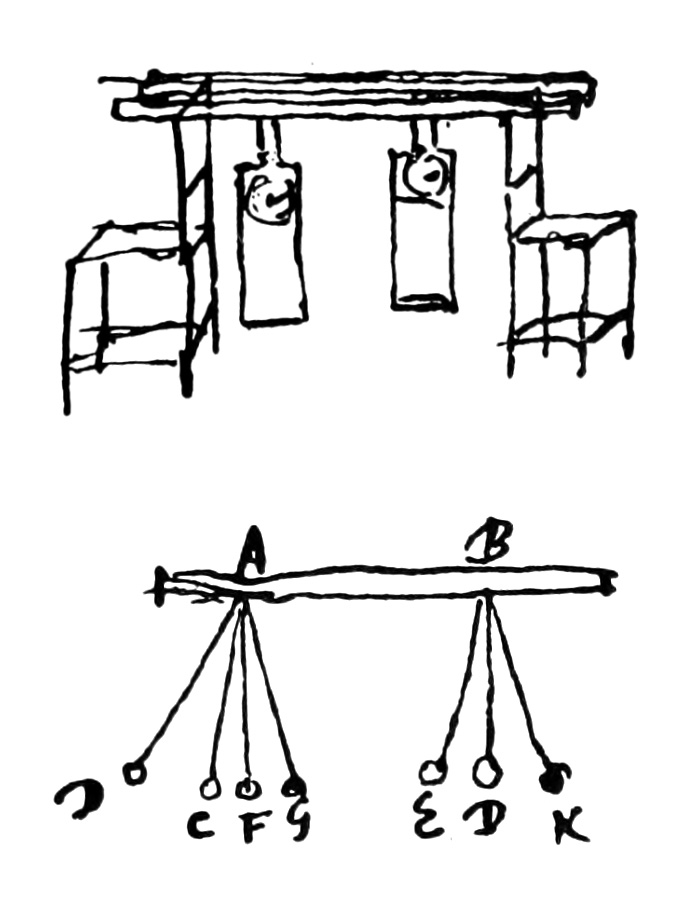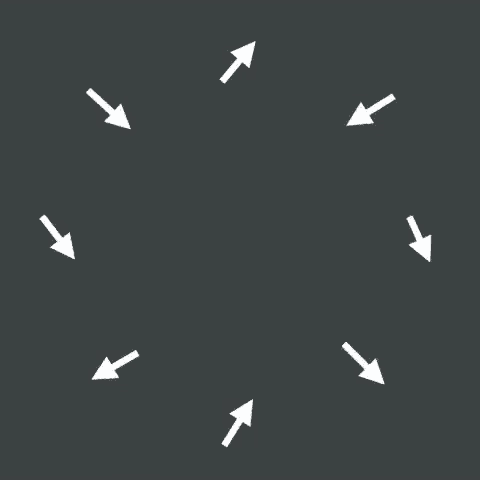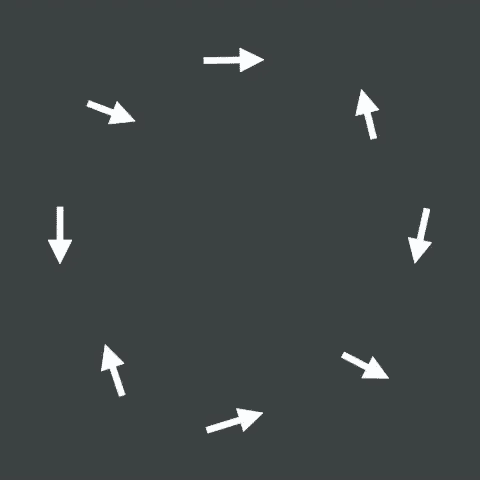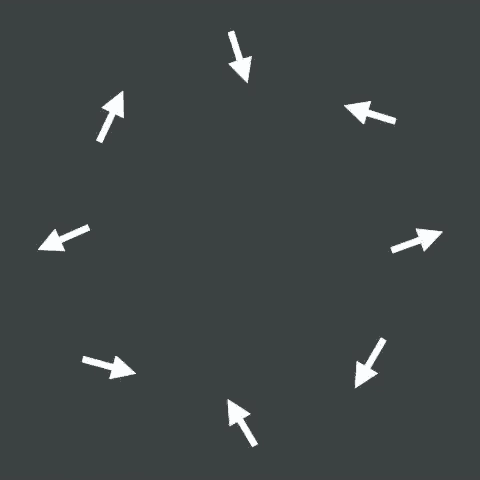Scientists Discover Exotic New Patterns of Synchronization
Introduction
When the incoherent claps of a crowd suddenly become a pulse, as everyone starts clapping in unison, who decided? Not you; not anyone. Crickets sing in synchrony; metronomes placed side by side sway into lockstep; some fireflies blink together in the dark. All across the United States, the power grid operates at 60 hertz, its innumerable tributaries of alternating current synchronizing of their own accord. Indeed, we live because of synchronization. Neurons in our brains fire in synchronous patterns to operate our bodies and minds, and pacemaker cells in our hearts sync up to generate the beat.
Objects with rhythms naturally synchronize. Yet the phenomenon went entirely undocumented until 1665, when the Dutch physicist and inventor Christiaan Huygens spent a few days sick in bed. A pair of new pendulum clocks — a kind of timekeeping device that Huygens invented — hung side by side on the wall. Huygens noticed that the pendulums swung exactly in unison, always lurching toward each other and then away. Perhaps pressure from the air was synchronizing their swings? He conducted various experiments. Standing a table upright between the clocks had no effect on their synchronization, for instance. But when he rehung the clocks far apart or at right angles to each other, they soon fell out of phase. Huygens eventually inferred that the clocks’ “sympathy,” as he called it, resulted from the kicks that their swings gave each other through the wall.
When the left pendulum swings left, it kicks the wall and the other pendulum rightward, and vice versa. The clocks kick each other around until they and the wall attain their most stable, relaxed state. For the pendulums, the most stable behavior is to move in opposite directions, so that each pushes the other in the direction it’s already going, the way you push a child on a swing. And this is also easiest for the wall; it no longer moves at all, because the pendulums are giving it equal and opposite kicks. Once in this self-reinforcing, synchronous state, there’s no reason for the system to deviate. Many systems synchronize for similar reasons, with kicks replaced by other forms of influence.

Christiaan Huygens’ sketch of an experiment with a pair of pendulum clocks (top), and his attempt to understand why they synchronize (bottom). “B has gone again through the position BD when A is at AG, whereby the suspension A is drawn to the right, and therefore the vibration of pendulum A is being accelerated,” he wrote. “B is again in BK when A has been returned to position AF, whereby the suspension of B is drawn to the left, and therefore the vibration of pendulum B slows down. And so, when the vibration of pendulum B is steadily slowing down, and A is being accelerated, it is necessary that … they should move together in opposite beats….”
Reproduced from Oeuvres complètes de Christiaan Huygens (1888); Huygens’ passage from Synchronization: A Universal Concept in Nonlinear Sciences (2002)
Another Dutchman, Engelbert Kaempfer, traveled to Thailand in 1690 and observed the local fireflies flashing simultaneously “with the utmost regularity and exactness.” Two centuries later, the English physicist John William Strutt (better known as Lord Rayleigh) noticed that standing two organ pipes side by side can “cause the pipes to speak in absolute unison, in spite of inevitable small differences.” Radio engineers in the 1920s discovered that wiring together electrical generators with different frequencies forced them to vibrate with a common frequency — the principle behind radio communication systems.
It wasn’t until 1967 that the pulsating chirps of crickets inspired the American theoretical biologist Art Winfree to propose a mathematical model of synchronization. Winfree’s equation was too difficult to solve, but in 1974, a Japanese physicist named Yoshiki Kuramoto saw how to simplify the math. Kuramoto’s model described a population of oscillators (things with rhythms, like metronomes and heartbeats) and showed why coupled oscillators spontaneously synchronize.
Kuramoto, then 34, had little prior experience in nonlinear dynamics, the study of the feedback loops that tangle together variables in the world. When he showed his model to experts in the discipline, they failed to grasp its significance. Discouraged, he set the work aside.
Five years later, Winfree came across a précis of a talk Kuramoto had given about his model and realized that it offered a revolutionary new understanding of a subtle phenomenon that pervades the world. Kuramoto’s math has proved versatile and extendable enough to account for synchronization in clusters of neurons, fireflies, pacemaker cells, starlings in flight, reacting chemicals, alternating currents and myriad other real-world populations of coupled “oscillators.”
“I didn’t imagine at all that my model would have a wide applicability,” said Kuramoto, now 78, by email.
But, as ubiquitous as Kuramoto’s model became, any illusions physicists had of understanding synchronization shattered in 2001. Once again, Kuramoto was at the center of the action.
Different Strokes
In Kuramoto’s original model, an oscillator can be pictured as an arrow that rotates in a circle at some natural frequency. (If it’s a firefly, it might flash every time the arrow points up.) When a pair of arrows are coupled, the strength of their mutual influence depends on the sine of the angle between their pointing directions. The bigger this angle, the bigger the sine, and therefore the stronger their mutual influence. Only when the arrows point in parallel directions, and rotate together, do they stop pulling on each other. Thus, the arrows will drift until they find this state of synchrony. Even oscillators that have different natural frequencies, when coupled, reach a compromise and oscillate in tandem.
But that basic picture only explains the onset of global synchronization, where a population of oscillators all do the same thing. As well as being the simplest kind of sync, “there are plenty of examples of global synchronization; that’s why people paid so much attention to that,” said Adilson Motter, a physicist at Northwestern University in Chicago, and a leading sync scientist. “But in 2001, Kuramoto discovered something very different. And that’s where the story of different states starts.”

Yoshiki Kuramoto, a professor of physics at Kyoto University, developed the famous Kuramoto model of synchronization in the 1970s and co-discovered the chimera state in 2001, again revolutionizing the understanding of sync.
Tomoaki Sukezane
It was Kuramoto’s Mongolian post-doc, Dorjsuren Battogtokh, who first noticed a new kind of synchronous behavior in a computer-simulated population of coupled oscillators. The identical oscillators, which were all identically coupled to their neighbors, had somehow split into two factions: Some oscillated in sync, while the rest drifted incoherently.
Kuramoto presented his and Battogtokh’s discovery at a 2001 meeting in Bristol, but the result didn’t register in the community until Steven Strogatz, a mathematician at Cornell University, came across it in the conference proceedings two years later. “When I came to understand what I was seeing in the graphics, I didn’t really believe it,” Strogatz said.
“What was so weird,” he explained, “was that the universe looks the same from every place” in the system. And yet the oscillators responded differently to identical conditions, some ganging together while the rest went their own way, as if not coupled to anything at all. The symmetry of the system “was broken,” Strogatz said, in a way that “had never been seen before.”
Strogatz and his graduate student Daniel Abrams, who now studies synchronization as a professor at Northwestern, reproduced the peculiar mix of synchrony and asynchrony in computer simulations of their own and explored the conditions under which it arises. Strogatz dubbed it the “chimera” state after a mythological fire-breathing monster made of incongruous parts. (Months earlier, Strogatz had written a popular book called Sync, about the pervasiveness of global synchronization.)
Two independent teams realized this chimera state in the lab in 2012, working in different physical systems, and more experiments have seen it since. Many researchers suspect chimeras arise naturally. The brain itself seems to be a complicated kind of chimera, in that it simultaneously sustains both synchronous and asynchronous firing of neurons. Last year, researchers found qualitative similarities between the destabilization of chimera states and epileptic seizures. “We believe that further detailed studies may open new therapeutic methods for promoting seizure prediction and termination,” said co-author Iryna Omelchenko of the University of Berlin.
But the chimera state is still not fully understood. Kuramoto worked out the math verifying that the state is self-consistent, and therefore possible, but that doesn’t explain why it arises. Strogatz and Abrams further developed the math, but other researchers want “a more seat-of-the-pants, physical explanation,” Strogatz said, adding, “I think it’s fair to say that we haven’t really hit the nail on the head yet” about why the chimera state occurs.
Good Vibrations
The discovery of chimeras ushered in a new era in sync science, revealing the conceivably countless exotic forms that synchronization can take. Now, theorists are working to pin down the rules for when and why the different patterns occur. These researchers have bold hopes of learning how to predict and control synchronization in many real-world contexts.
Motter and his team are finding rules about how to stabilize the synchronization of power grids and more stably integrate the U.S. grid with intermittent energy sources like solar and wind. Other researchers are looking for ways of nudging systems between different synchronous states, which could be useful for correcting irregular heartbeats. Novel forms of sync could have applications in encryption. Scientists speculate that brain function and even consciousness can be understood as a complicated and delicate balance of synchrony and asynchrony.
“There’s a lot of new vibrancy to thinking about sync,” said Raissa D’Souza, a professor of computer science and mechanical engineering at University of California, Davis. “We’re gaining the tools to look at these exotic, intricate patterns beyond just simple, full synchronization or regions of synchronization and regions of randomness.”
Many of the new synchronization patterns arise in networks of oscillators, which have specific sets of connections, rather than all being coupled to one another, as assumed in the original Kuramoto model. Networks are better models of many real-world systems, like brains and the internet.
In a seminal paper in 2014, Louis Pecora of the United States Naval Research Laboratory and his co-authors put the pieces together about how to understand synchronization in networks. Building on previous work, they showed that networks break up into “clusters” of oscillators that synchronize. A special case of cluster sync is “remote synchronization,” in which oscillators that are not directly linked nonetheless sync up, forming a cluster, while the oscillators in between them behave differently, typically syncing up with another cluster. Remote synchronization jibes with findings about real-world networks, such as social networks. “Anecdotally it’s not your friend who influences your behavior so much as your friend’s friend,” D’Souza said.
In 2017, Motter’s group discovered that oscillators can remotely synchronize even when the oscillators between them are drifting incoherently. This scenario “breeds remote synchronization with chimera states,” he said. He and his colleagues hypothesize that this state could be relevant to neuronal information processing, since synchronous firing sometimes spans large distances in the brain. The state might also suggest new forms of secure communication and encryption.
Then there’s chaotic synchronization, where oscillators that are individually unpredictable nonetheless sync up and evolve together.
As theorists explore the math underpinning these exotic states, experimentalists have been devising new and better platforms for studying them. “Everyone prefers their own system,” said Matthew Matheny of the California Institute of Technology. In a paper in Science last month, Matheny, D’Souza, Michael Roukes and 12 co-authors reported a menagerie of new synchronous states in a network of “nanoelectromechanical oscillators,” or NEMs — essentially miniature electric drumheads, in this case. The researchers studied a ring of eight NEMs, where each one’s vibrations send electrical impulses to its nearest neighbors in the ring. Despite the simplicity of this eight-oscillator system, “we started seeing a lot of crazy things,” Matheny said.
The researchers documented 16 synchronous states that the system fell into under different initial settings, though many more, rare states might be possible. In many cases, NEMs decoupled from their nearest neighbors and remotely synchronized, vibrating in phase with tiny drumheads elsewhere in the ring. For example, in one pattern, two nearest neighbors oscillated together, but the next pair adopted a different phase; the third pair synced up with the first and the fourth pair with the second. They also found chimeralike states (though it’s hard to prove that such a small system is a true chimera).



Many exotic new synchronization patterns were seen in experiments with a ring of eight connected oscillators. In the “splay state” on top, each oscillator’s phase differs by a set amount from its neighbors’. In the “traveling wave state” in the center, only arrows opposite each other on the ring stay in phase. The state on the bottom is a “noise-driven chimera”: Two sets of arrows are always synced across the ring, while arrows in between jump in and out of sync with their neighbors, seemingly at random.
Many exotic new synchronization patterns were seen in experiments with a ring of eight connected oscillators. In the “splay state” on the left, each oscillator’s phase differs by a set amount from its neighbors’. In the “traveling wave state” in the center, only arrows opposite each other on the ring stay in phase. The state on the right is a “noise-driven chimera”: Two sets of arrows are always synced across the ring, while arrows in between jump in and out of sync with their neighbors, seemingly at random.
Matheny et al./Science
NEMs are more complicated than simple Kuramoto oscillators in that the frequency at which they oscillate affects their amplitude (roughly, their loudness). This inherent, self-referential “nonlinearity” of each NEM gives rise to complex mathematical relationships between them. For instance, the phase of one can affect the amplitude of its neighbor, which affects the phase of its next-nearest neighbor. The ring of NEMs serves as “a proxy for other things that are out in the wild,” said Strogatz. When you include a second variable, like amplitude variations, “that opens up a new zoo of phenomena.”
Roukes, who is a professor of physics, applied physics and biological engineering at Caltech, is most interested in what the ring of NEMs suggests about huge networks like the brain. “This is very, very primordial compared to the complexity of the brain,” he said. “If we already see this explosion in complexity, then it seems feasible to me that a network of 200 billion nodes and 2,000 trillion [connections] would have enough complexity to sustain consciousness.”
Broken Symmetries
In the quest to understand and control the way things sync up, scientists are searching for the mathematical rules dictating when different synchronization patterns occur. That major research effort is unfinished, but it’s already clear that synchronization is a direct manifestation of symmetry — and the way it breaks.
The link between synchronization and symmetry was first solidified by Pecora and co-authors in their 2014 paper on cluster synchronization. The scientists mapped the different synchronized clusters that can form in a network of oscillators to that network’s symmetries. In this context, symmetries refer to the ways a network’s oscillators can be swapped without changing the network, just as a square can be rotated 90 degrees or reflected horizontally, vertically or diagonally without changing its appearance.
D’Souza, Matheny and their colleagues applied the same potent formalism in their recent studies with NEMs. Roughly speaking, the ring of eight NEMs has the symmetries of an octagon. But as the eight tiny drums vibrate and the system evolves, some of these symmetries spontaneously break; the NEMs divide into synchronous clusters that correspond to subgroups of the “symmetry group” called D8, which specifies all the ways you can rotate and reflect an octagon that leave it unchanged. When the NEMs sync up with their next-nearest neighbors, for example, alternating their pattern around the ring, D8 reduces to the subgroup D4. This means the network of NEMs can be rotated by two positions or reflected across two axes without changing the pattern.
Even chimeras can be described in the language of clusters and symmetry subgroups. “The synchronized part is one big synchronized cluster, and the desynchronized part is a bunch of single clusters,” said Joe Hart, an experimentalist at the Naval Research Lab who collaborates with Pecora and Motter.
Synchronization seems to spring from symmetry, and yet scientists have also discovered that asymmetry helps stabilize synchronous states. “It is a little bit paradoxical,” Hart admitted. In February, Motter, Hart, Raj Roy of the University of Maryland and Yuanzhao Zhang of Northwestern reported in Physical Review Letters that introducing an asymmetry into a cluster actually strengthens its synchrony. For example, making the coupling between two oscillators in the cluster unidirectional instead of mutual not only doesn’t disturb the cluster’s synchrony, it actually makes its state more robust to noise and perturbations from elsewhere in the network.
These findings about asymmetry hold in experiments with artificial power grids. At the American Physical Society meeting in Boston last month, Motter presented unpublished results suggesting that “generators can more easily oscillate at the exact same frequency, as desired, if their parameters are suitably different,” as he put it. He thinks nature’s penchant for asymmetry will make it easier to stably sync up diverse energy supplies.
“A variety of tasks can be achieved by a suitable combination of synchrony and asynchrony,” Kuramoto observed in an email. “Without a doubt, the processes of biological evolution must have developed this highly useful mechanism. I expect man-made systems will also become much more functionally flexible by introducing similar mechanisms.”
Editor’s note: Raissa D’Souza and Steven Strogatz are members of this magazine’s advisory board.
This article was reprinted on Wired.com.





